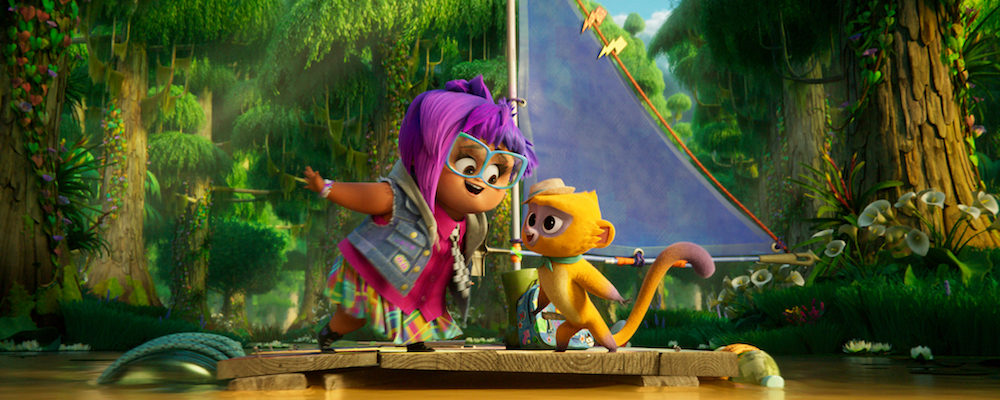‘Vivo’ Sparks Some Cuban Magic Before Aiming for Bland Shores
Alci Rengifo
Cuteness can’t save every animated concept involving singing pets. Take for example, Netflix’s “Vivo,” which begins with a lot of promise as an adventure opening in Cuba. In this emerging era of new diversity in film, the idea of a Cuban animated movie is quite exciting. Originally a Sony release, “Vivo” was bought by Netflix last year during the pandemic’s initial impact on the box office. Alas, maybe it’s lingering political jitters in Hollywood, but the story quickly becomes a standard cartoon romp. So standard, in fact, that it feels over in 15 minutes. Truth be told, it will probably work fine for very young viewers, who won’t yet have the critical ear to assess how Lin-Manuel Miranda recycles himself like a studio musician phoning it in. They will chortle at the evil python and still not have the cultural know-how to wonder why the movie couldn’t stay in Havana. But those of us paying the Netflix bill will.
The movie does indeed open in modern-day Cuba, where aged musician Andrés (Juan de Marcos González) plays his music by the Malecón, Havana’s famous seawall. His constant companion and fellow musician is a kinkajou named Vivo (Miranda), who arrived on the island in a crate when he was a baby. Then a letter arrives for Andrés from his long lost love, Marta Sandoval (Gloria Estefan), who left Cuba years ago in the ‘60s (the movie is too shy to say it was probably because of the revolution) and is now a famous singer in Miami. Marta’s great wish is that Andrés would sing with her again. He vows to go to Florida and give her a love song he once composed in her honor. But after packing his suitcase, Andrés’s heart gives out and he dies in his sleep. His surviving relatives, niece Rosa (Zoe Saldana) and her daughter Gabi (Ynairaly Simo), arrive in Havana to pick up Andrés’s belongings. For Vivo it’s the perfect chance to hop into Gabi’s luggage and make his way to Miami to deliver the song himself.
It is when Vivo leaves Cuba that “Vivo” as a movie trades in vibrant originality for colorful animation that rehashes most furry road trip clichés. Director Kirk DeMicco also made “The Croods,” which made early prehistoric humans quite heartwarming, and “Space Chimps,” a goofy little delight. The screenplay is written by DeMicco with Quiara Alegría Hudes, who won a Pulitzer Prize for penning the musical “In the Heights,” a Lin-Manuel Miranda hit onstage that translated to an excellent film audiences have avoided. Miranda writes the songs here as well. Yet everyone seems to be working at half their usual inspiration. The opening passages of the film are warm and enticing, with velvety Cuban sunsets and glimpses of daily Havana life. A visual consultant on the film was master cinematographer Roger Deakins. It’s a place we never see in animated films, only as another cliché in action movies or political dramas. Hand-drawn flashbacks to Andrés days as a musician with Marta in pre-revolution Havana are intriguing enough to warrant their own movie.
Out of the island nation, Vivo first lands in Key West, where we get to meet Gabi as a rebellious kid who antagonizes her girl scout troop, the Sand Dollars, who are tyrannical environmentalists. At home she also gives Rosa constant headaches. It’s soon clear this stems from Gabi having lost her father not too long ago. He was the musician with the sense of humor, while Rosa is the stern parent. Gabi’s self-introduction to Vivo is also the movie’s best song number, “My Own Drum,” an energetic stomper of a jam. Gabi becomes determined to help Vivo get Andrés’s song to Marta in Miami. It’s unclear how she communicates with Vivo, since the movie makes clear that to the outside world he makes kinkajou noises, while we hear the Miranda translation. No matter, off they go into the movie’s stale middle section which is mostly set in swamplands. Vivo avoids getting eaten by a snake (Michael Rooker) who hates noises, and meets a spoonbill (Brian Tyree Henry) who has given up on mating season and prepares to hibernate instead. Gabi survives a massive storm and is found by the Sand Dollars, who are easy to win over once she promises to save a particular swamp animal. Many of these sequences are excuses for Miranda songs that don’t have much Cuban flavor to them. They sound like his usual rap-pop-Latin shtick, only this time we suspect these are the kinds of songs he keeps in the desk drawer.
And that’s pretty much it until the pair makes it to a neon-lit Miami, where Marta sits in her dressing room, waiting for Andrés. If you have seen many animated throwaways then you know how the rest of “Vivo” will progress. Iconic diva Estefan can’t save the rest of the show, which gives her a song that isn’t terrible, but not necessarily memorable. Estefan recently came out in support of keeping the (rather senseless) U.S. blockade of Cuba in place, so maybe that explains why the island itself remains blocked off in the movie. Instead of a real Cuban adventure we get a bland rush into Miami, which even then looks like any other CGI American city. Some of the other visuals are still a delight and the voice work of young actor Ynairaly Simo is vivacious. It’s a great feature debut and hopefully we will see more of her soon. “Vivo” ends as a curious animated movie where the opening was the high point. If it had kept its initial rhythm it could have been something special. It will surely entertain its intended audience, but will offer them little that they haven’t seen before.
“Vivo” begins streaming Aug. 6 on Netflix.

